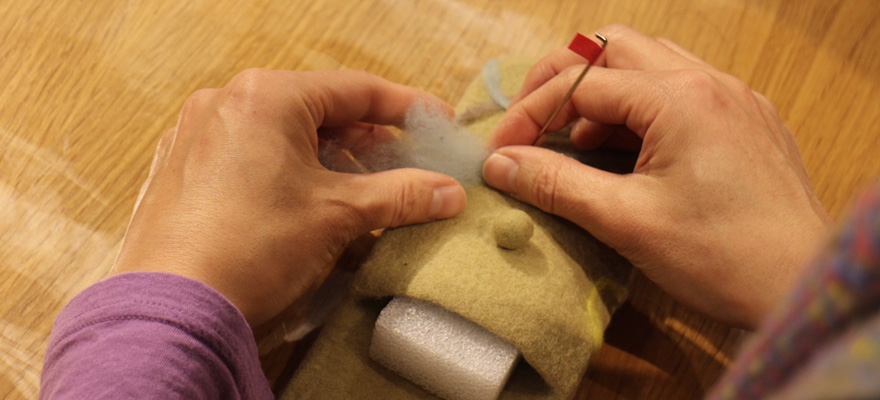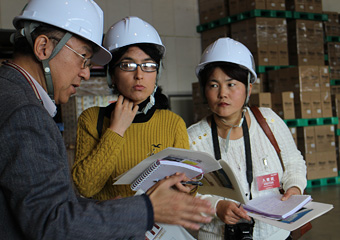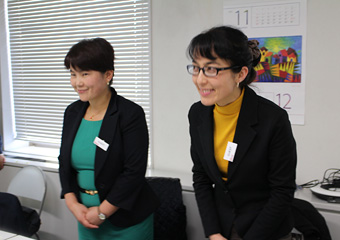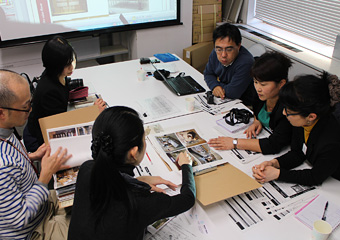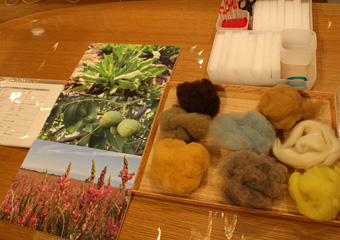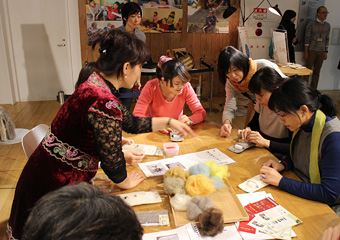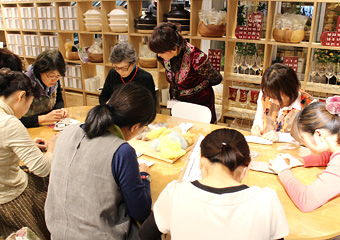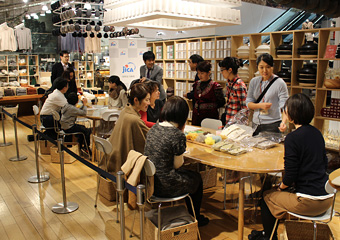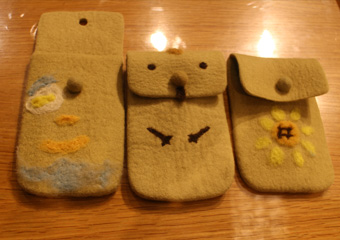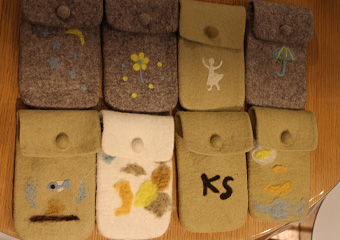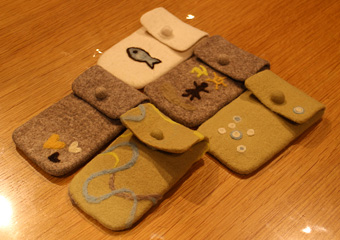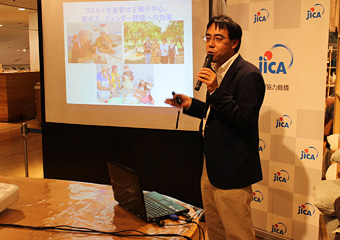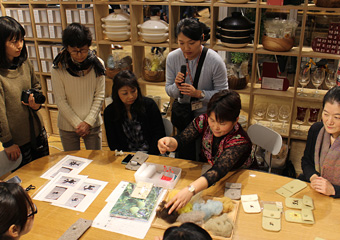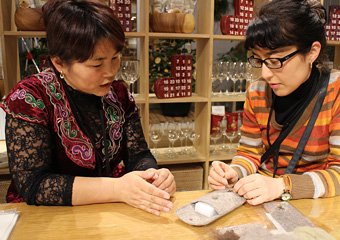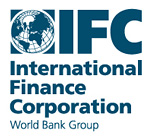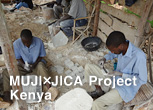#06 Leaders of Kyrgyzstan OVOP Program visited us here in Japan.
This summer we met with the operations team of the OVOP(One Village One Product) Program in Kyrgyzstan. At the meeting, we had discussions on the issues that must be resolved for further improvements and the next steps to be achieved. There, we received requests from the operations team for a training opportunity regarding management. Visits to Kyrgyzstan in the past had covered issues related to product quality and product design. However, it was our first time to receive requests for management skill trainings.
We felt a strong intention of the operations team to further expand the business, and decided to support this request. By working with JICA we were at last able to welcome Ms Makhabat Zhakeeva (Chairperson) and Ms. Erkinbaeva Nargiza (Public Relation Officer) at our Tokyo Head Office.
We wanted to introduce the OVOP program and the Kyrgyzstan felt products to as many people as possible, and arranged a workshop at MUJI Yurakucho, where customers were able to experience making felt items. In this edition, we would like to introduce some of the experiences we shared with our Kyrgyzstan visitors.
1.Management Training Session (at MUJI Head Office) December 4th - 5th, 2013.
The contents of the training were based on requests from the Kyrgyzstan members, and over a period of two days, we shared our business knowledge with them, through staffs with the best knowledge of the requested subject.
1-1.Quality Assurance and Production Management Session
In this session, the greatest interest of the Kyrgyzstan members were, how quality is assured and how production is managed at MUJI. The OVOP project also has dietary products in their product line. Therefore, nearly 1000 personnel must be managed to have the same knowledge about sanitary conditions and stable production of good quality products. Therefore, we explained details on sanitation and basic production management standards by using check sheets actually used at MUJI for quality assurance and production management. Of course, the same kind of check sheets are used at the Kyrgyzstan production sites, so we mainly covered the points which we thought could be useful for further improvements.
 A picture of the quality assurance and production management session.
A picture of the quality assurance and production management session.

1-2.Warehouse Visit and Logistics Management Session
One of the big tasks for the operations team is to gather and store items which have been produced at sites located, at times, as far as 700 km away, before exporting the products. Also they must deliver requested quantities in a timely manner to hotels, gas stations and stores. Therefore, to learn about MUJI logistics structure and standards was very important for them.
Although it was a short stay for the Kyrgyzstan members, we were able to show them our warehouse in Urayasu, Chiba prefecture. Here, we explained and showed how items are received from our manufacturers and how the products are stored, how items are inspected and tagged and how finally the products are shipped to our stores and customers.
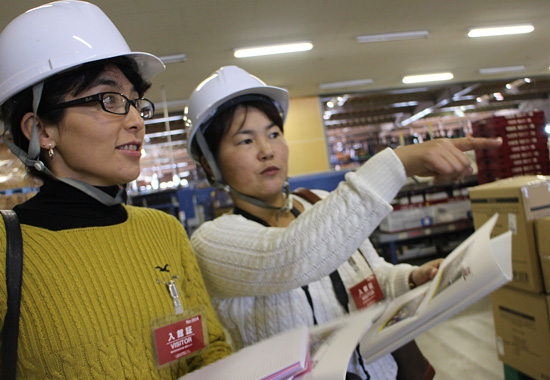 Ms. Erkinbaeva Nargiza(left), and Ms. Makhabat Zhakeeva(right).
Ms. Erkinbaeva Nargiza(left), and Ms. Makhabat Zhakeeva(right).
 Urayasu warehouse in Chiba prefecture.
Urayasu warehouse in Chiba prefecture.
1-3.Product Development and Marketing Session
This session covered processes of product development and MUJI marketing principles. As MUJI does, products are designed by the OVOP program members and production is sourced out to their manufactures. This means they apply a business model to sell their own branded products. We had a Q&A session for analyzing methods in relations to product development, including market research methods, data analysis methods, budgeting methods, product planning methods, and also details were discussed about actual steps followed at MUJI when developing products. Also basic marketing theory and cases studies were introduced, together with hot selling products in Japan and the reasons for their high sales results.
1-4.Basic Customer Service Session : Servicing and VMD (Visual Merchandizing)
At MUJI, we have a standard manual called "MUJIGRAM" for all our work routines to efficiently manage our daily schedules. This manual is configured by the division related to the routine, and during this session, we explained our approach for manual configuration and management issues based on the MUJIGRAM. We tried out the greetings and smile expression training with the Kyrgyzstan members and also explained effective display methods based on basic VMD (visual merchandizing) rules by comparing different store front photographs.
The OVOP program in Kyrgyzstan have stores of their own, and by introducing Japanese methods of store management, hope will be of good use at Kyrgyzstan, too, incorporated in their own way.
Greetings and smile expression training session.
Introduction to basic VMD (visual merchandizing) rules by comparing store front displays.
2.Workshop at MUJI Yurakucho December 7th -8th, 2013
On December 7th and 8th, we held a workshop to introduce the Kyrgyzstan felt items at MUJI Yurakucho. The workshop consisted of 3 parts.
Part 1: Felt Stitching Workshop "Stitch on your original motif".
Part 2: Introduction to The Republic of Kyrgyz and the progress of JICA OVOP program in Kyrgyzstan (by Mr. Akihisa Haraguchi).
Part 3: Felt making demonstration by Ms. Makhabat Zhakeeva.
Manufacturers in Kyrgyzstan were introduced through panels. Also, items from other JICA OVOP program, such as the program in Kenya, was introduced through pamphlets, making this event a JICA officially supported event.
Many people took part in the event, and we would like to take this opportunity to thank all participants for their support.
2-1.Felt Stitching Workshop "Stitch on your original motif"
The felt mobile case made in Kyrgyzstan has been a popular MUJI X JICA item for the past three years. This item has a petroglyph motif (a symbolic picture taken from sculpted drawings on rocks, originated to nomads from central Asia), such as the argali, dancer and fighter, stitched. For the workshop, we prepared felt mobile cases without motifs and asked each participant to stitch on their original motifs.

Felts used were made in Kyrgyzstan from natural non dyed wool or wool dyed in plant dye. Using a needle specific for felt stitching, participants stitched on original motifs. Although felt stitching is detailed work requiring concentration, it is quite absorbing and enjoyable once you start.
Plants used for the dye are local plants which grow in Kyrgyzstan.
First, Ms. Makhabat Zhakeeva demonstrated the stitching process.
Ms. Makhabat Zhakeeva carefully explained how to stitch the motif. The dress worn by Ms. Makhabat Zhakeeva is a traditional Kyrgyzstan gown.
A photograph of a participants concentrating on stitching.
These are some of the original mobile cases made at the workshop.
2-2.Introduction to the progress of JICA OVOP program in Kyrgyzstan by JICA Project Leader
Mr. Akihisa Haraguchi introduced the Republic of Kyrgyz, and the region around Lake Issyk-Kul where the felt products are made. He also spoke about the manufacturers and the progress of OVOP program in Kyrgyzstan, which MUJI and JICA have worked together for the past three years.
Special focus was made on the manufacturers living around Lake Issyk-Kul who are mostly women. These women do not have many opportunities to interact with people outside of their village before taking part in the OVOP program. Their participation resulted work, income and chances for interaction with people outside the village, and needless to say, opportunities for the women to ask their family to help them with housework. Mr. Haraguchi's explanation was easy to understand, and drew attention and interest of the participants.
Mr Akihisa Haraguchi, Project Leader of the JICA OVOP program for Kyrgyzstan.
Mr. Haraguchi is working with local members to organize and train the members, and brand the products from Kyrgyzstan.
2-3.Felt making demonstration by Ms. Makhabat Zhakeeva
Ms. Makhabat Zhakeeva is the Chairman of the manufacturers. She is also the leader in charge of standardizing the quality of the products. She manages 200 to 300 felt manufacturers by configuring specifications and manufacturing method standards and she is a great person with many skills. This time through the workshop, we were able to witness her felt making skills.
We received many questions at the workshop, and it was a fruitful experience to see how felt is processed and shaped.
Felt is made and shaped using wool, water and soap (wet felting technique).
Once the felt is shaped, punching technique is used to stitch on petroglyph motifs and to shape animal figures.
3.Last but not least...
It was a great joy for us to be able to welcome the Kyrgyzstan members at MUJI, Japan. We hope that the training sessions will be of help to their management requirements back in home. It was a big outcome for us, that many people attended the workshop and grew an interest towards the project and Kyrgyzstan through this experience.
This MUJI X JICA project started as part of the MUJI gift item development and we would be delighted if you were to choose an ethical item for your holiday gift this year.
We will continue to support the program and Kyrgyzstan members and hope to enhance the project together.
Please look forward to our next year's line-up!
Reference: Petroglyph symbols and their meanings
| Symbol | Name | Meaning (English) | Meaning (Japanese) |
|---|---|---|---|
 |
Fighter | Courage Honor |
勇気 名誉 |
 |
Argali | Wealth Speed |
富、財 スピード |
 |
Dancer | Merriment | お祭り、楽しいこと |
This column has been written by a MUJI project member with the cooperation of JICA Kyrgyz.
